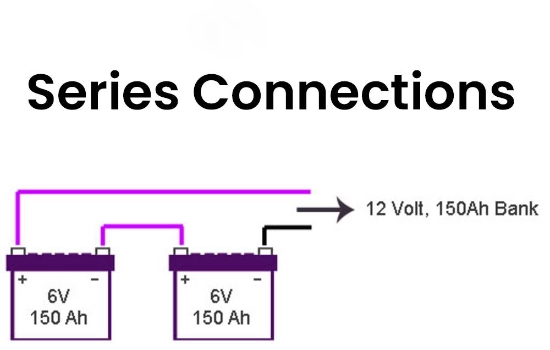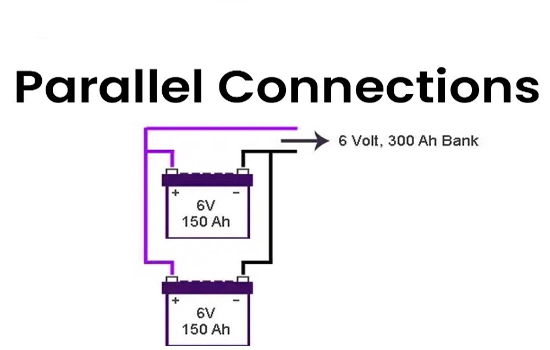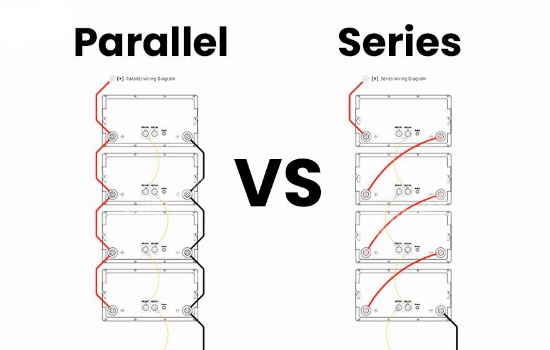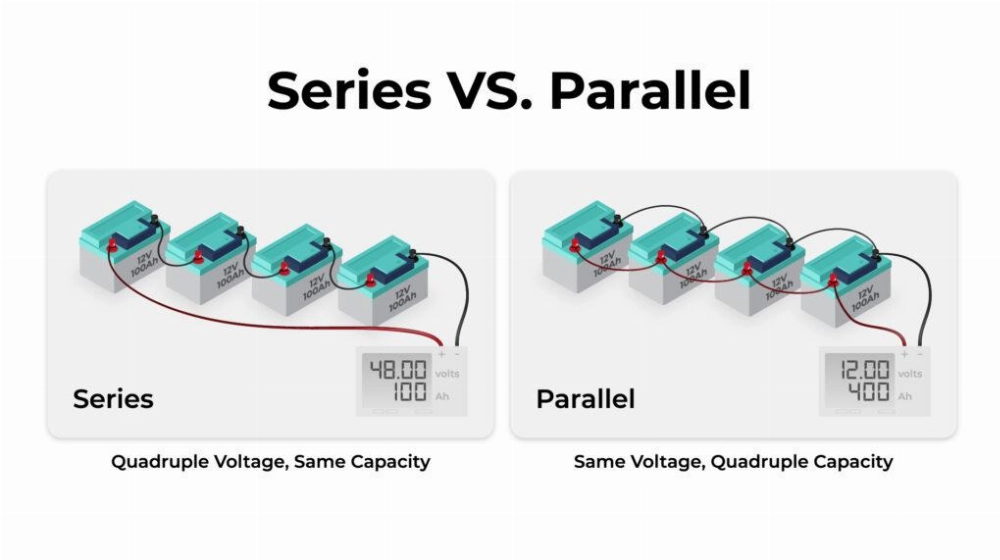At KHZH, we understand that choosing the right battery configuration for your specific needs is crucial. This article explores the differences between series and parallel battery connections, helping you make an informed decision. We will break down the pros and cons of each method, making it easy for everyone to understand.
Series vs. Parallel Batteries: Key Differences
Series connections increase the voltage but maintain the same capacity, making them ideal for applications that require higher voltage. Parallel connections, on the other hand, increase the capacity while maintaining the same voltage, making them better suited for devices needing longer run times. In this guide, we will compare these configurations, offering insights into when and how to use each more effectively.
Part 1: Series Batteries

When batteries are connected in series, their positive terminal is connected to the negative terminal. This configuration increases the voltage while maintaining the same current. For example, connecting two 1.5-volt batteries in series results in a total voltage of 3 volts.
Advantages
- Voltage Boost:
The most significant advantage of series connections is the increased voltage. For example, four 1.5-volt batteries connected in series produce a total output of 6 volts. This is essential for applications requiring higher voltages, such as specific electronic devices or power tools. - Enhanced Compatibility:
Series connections support devices designed for higher voltages, allowing seamless integration with systems requiring more voltage than a single battery offers. - Consistent Current Distribution:
In a series arrangement, the current flowing through each battery remains consistent. This uniform current is crucial for applications that require a stable power source, helping maintain optimal performance.
Disadvantages
- Overcharging and Imbalanced Discharge:
Differences in charging or discharging rates can lead to imbalances, especially if one battery has lower capacity or discharges more quickly. This can cause overcharging, potential damage, or shortened battery life. - Reliance on Single Battery Health:
Series connections rely on the performance of each battery. If one battery fails, the entire circuit may be interrupted, reducing efficiency or causing system failure. - No Capacity Increase:
While the voltage increases, the total capacity (amp-hours) remains equal to that of a single battery. This limits their use in applications that require extended operation without frequent recharging.
Part 2: Parallel Batteries
When batteries are connected in parallel, their positive terminals are connected to each other, and their negative terminals are connected to each other. This setup maintains the same voltage across the batteries but increases the total capacity. For example, two 1.5-volt batteries connected in parallel still produce 1.5 volts, but the combined capacity increases, providing longer power duration.
Advantages
- Enhanced Capacity Without Voltage Change:
Parallel connections significantly increase the total capacity without altering the voltage. This makes them ideal for applications requiring extended power, such as UPS systems or solar power storage. - Balanced Performance and Longevity:
Parallel setups allow for balanced charging and discharging, reducing the risk of uneven wear. - Redundancy and Reliability:
Unlike series connections, parallel arrangements can continue to function even if one battery fails, as the remaining batteries can sustain the power supply. This redundancy ensures greater reliability in critical applications.
Which Configuration is Right for You?
Choosing between series and parallel connections depends on your specific requirements. If your application needs higher voltage, series connections are preferable. However, if increased capacity and longer run times are needed, a parallel setup is preferable. Understanding the key differences can help you optimize your power system and ensure reliable performance.
Stay tuned to KHZH for more insights and practical advice on battery configurations and power solutions.
Advantages of Parallel Battery Connections
1. Increased Capacity and Extended Runtime
Connecting batteries in parallel effectively expands the total capacity, ensuring longer runtime. This feature is particularly beneficial for devices requiring continuous power, such as Uninterruptible Power Supplies (UPS), renewable energy storage systems, and electric vehicles. By distributing the load across multiple batteries, users can achieve longer use without frequent recharges.
2. Improved Energy Storage Solutions
Parallel connections optimize energy storage efficiency, making them ideal for solar energy storage and grid energy solutions. By combining multiple batteries, energy storage capacity can be maximized, ensuring a stable power supply even during peak demand or intermittent power generation.
3. Enhanced Redundancy and Reliability
Parallel battery configurations offer built-in redundancy, ensuring continuous power supply even if one battery fails. This feature is crucial for mission-critical applications such as medical equipment, telecommunications, and emergency lighting systems, where uninterrupted power is essential.
Disadvantages of Parallel Battery Connections
1. Uniform Voltage Output
Despite the increased capacity, the voltage output remains the same as a single battery. Applications requiring higher voltage may need additional circuitry or series connections to achieve the desired power levels.
2. Complex Management Requirements
Inconsistencies in battery performance or capacity can lead to imbalances over time, requiring proactive maintenance. This is particularly important in large-scale systems, such as grid storage or backup power applications.
3. Compatibility Challenges
Some electronic devices may not be compatible with parallel battery configurations due to voltage specifications. In such cases, series connections may be more suitable for achieving the required voltage levels without compromising performance.
Series vs. Parallel Battery Connections – Key Comparisons
Voltage, Capacity, and Current Analysis
Voltage:
- Series Connection: The total voltage is the sum of the individual battery voltages. For example, three 1.5V batteries in series yield 4.5V.
- Parallel Connection: The voltage remains equal to that of a single battery. Three 1.5V batteries in parallel still output 1.5V.
Capacity (mAh):
- Series Connection: The total capacity remains the same as the capacity of a single battery. Three 1000mAh batteries in series still provide a total of 1000mAh.
- Parallel Connection: The total capacity is the sum of all connected batteries. Three 1000mAh batteries in parallel provide a combined capacity of 3000mAh.
Current:
- Series Connection: The current is the same at all points in a series circuit.
- Parallel Connection: Each battery contributes to the total current, increasing the overall current capacity.
Suitability and Practical Examples
Series Connection:
- Best suited for applications requiring higher voltage levels, such as power tools, electronic circuits, and industrial machinery.
Parallel Connection:
- Suitable for applications requiring extended runtime without increased voltage, including backup power systems, renewable energy storage, and electric vehicles.
Series or Parallel: Which is Best?
- Series for Higher Voltage: When a higher voltage is needed, series connections are the preferred solution, eliminating the need for additional step-up circuitry.
- Parallel for Longer Runtime: If longer power supply duration is the priority, parallel connections offer superior performance without increasing voltage levels.
Quick Comparison Table
| Parameter | Series Batteries | Parallel Batteries |
|---|---|---|
| Voltage | Sum of individual voltages | Equal to a single battery |
| Capacity (mAh) | Same as a single battery | Sum of individual capacities |
| Applications | High-voltage devices (e.g., tools, electronics) | Long-runtime devices (e.g., UPS, solar storage) |
| Redundancy | Single battery failure leads to system failure | Single battery failure does not affect system operation |
KHZH ensures reliable, efficient, and optimized battery solutions tailored for various applications. Understanding the differences between series and parallel connections empowers users to make
Part 4: Practical Application Scenarios for Series and Parallel Connections
Understanding when to use series or parallel battery connections can improve efficiency and optimize performance.
Series Connection:
- Ideal for devices that require high voltage, such as power tools, flashlights, or appliances with specific voltage requirements.
Parallel Connection:
- Best suited for applications that require extended run times, such as power banks, solar power systems, or electric vehicles.
Combined Use:
- Some systems integrate both series and parallel configurations, like large solar grids, to achieve both high voltage and increased capacity.
Part 5: How to Connect Batteries in Series?
Materials Needed:
- Batteries: Ensure all batteries are of the same type, voltage rating, and capacity to prevent imbalances and safety hazards.
- Connecting Wires: Use appropriately rated wires that can handle the current without overheating or causing excessive voltage drops.
Step-by-Step Process:
- Check Batteries: Before connecting any batteries, confirm they are all the same type, voltage, and capacity.
- Identify Terminals: Locate the positive (+) and negative (-) terminals on each battery.
- Connect Positive to Negative: Connect the positive (+) terminal of the first battery to the negative (-) terminal of the second battery. Continue this pattern for additional batteries.
- Secure Connections: Use quality wires and connectors to establish secure, insulated connections and prevent short circuits.
- Verify Configuration: Ensure the series setup forms a continuous chain, leaving the positive terminal of the first battery and the negative terminal of the last battery unconnected.
- Test Setup: Use a multimeter to measure the total voltage and confirm the expected cumulative voltage output.
- Implement Safety Measures: Take Safety Precautions, such as preventing short circuits and handling batteries with care.
Part 6: How to Connect Batteries in Parallel?
Materials Needed:
- Batteries: Ensure all batteries are of the same type, voltage rating, and capacity for balanced performance.
- Connecting Wires: Use cables with sufficient current rating to handle the required current.
Step-by-Step Process:
- Check Battery Compatibility: Confirm that all batteries have the same specifications to avoid performance issues.
- Identify Terminals: Clearly identify the positive (+) and negative (-) terminals on each battery.
- Connect the Positive Terminals: Connect all positive (+) terminals of the batteries together using a common cable.
- Connect the Negative Terminals: Connect all negative (-) terminals of the batteries together using a separate cable.
- Secure Connections: Ensure secure, insulated connections to prevent poor contact and electrical hazards.
- Verify Configuration: Double-check that all positive terminals are connected together and all negative terminals are connected together.
- Testing: Use a multimeter to measure the voltage output and ensure the total voltage matches the expectation.
By following these guidelines, KHZH ensures efficient and safe battery configurations, optimizing battery performance.
Series and Parallel Battery Connections: Key Differences and Considerations
When designing or using battery systems, understanding the difference between series and parallel connections is crucial. Each connection method serves a specific purpose, and choosing the right one depends on your power needs. Here’s an overview:
Series Connection:
Series connections increase the voltage by connecting batteries in a chain, positive terminal to negative terminal. For example, two 3.7V batteries in series will provide a total of 7.4V. However, the total capacity (measured in mAh) remains the same as a single battery. Series connections are ideal for devices that require higher voltages, such as power tools or certain electronics.
Parallel Connection:
Parallel connections increase the capacity by connecting positive terminals to each other and negative terminals to each other. This setup maintains the same voltage as a single battery but increases the total capacity (mAh). Parallel connections are better suited for devices that require longer run times, such as portable electronics or energy storage systems.
Choosing the Right Connection for Your Needs
- Series connections are best for applications that require a higher voltage.
- Parallel connections are better suited for applications that require longer battery life or increased capacity.
Key Considerations
- Safety Precautions: Handling batteries requires extra care. Always adhere to established safety protocols when working with batteries or electrical components to prevent short circuits and other potential hazards. For an in-depth discussion on safety concerns related to battery configurations, see our article on Parallel and Series Battery Safety Concerns.
- Can You Mix Batteries of Different Capacities?
It is not recommended to mix batteries of different capacities, voltages, or types in series or parallel connections. Doing so can lead to imbalances, reduced efficiency, overheating, and potential damage to the batteries or the device.
- Lifespan of Batteries in Series vs. Parallel:
- In series, the lifespan of the battery pack is typically determined by the weakest battery in the series, meaning if one battery fails, the entire system may stop working, potentially causing a complete system failure.
- In parallel connections, the batteries share the load, which can extend the overall lifespan. If one battery fails, the remaining batteries may continue to work, but the total capacity will be reduced.
- What Happens If One Battery Fails?
- In a series setup, the failure of one battery typically causes the entire system to fail because the batteries are dependent on each other for voltage.
- In a parallel configuration, the failure of one battery may not immediately affect the others, but the system’s total capacity will decrease (as there is one less battery contributing), reducing the available power.
Conclusion
Choosing between series and parallel connections ultimately depends on the voltage and run time requirements of your device. Series connections increase voltage, while parallel connections enhance capacity and longevity. Always consider your application needs and follow safety guidelines to ensure optimal performance.










